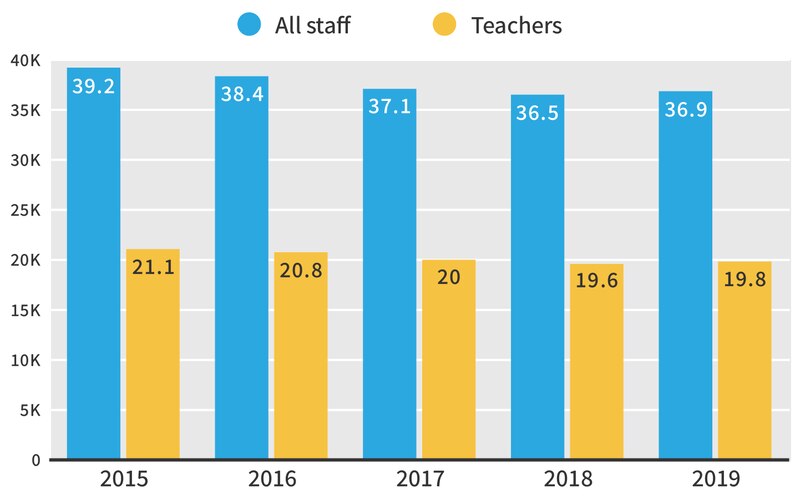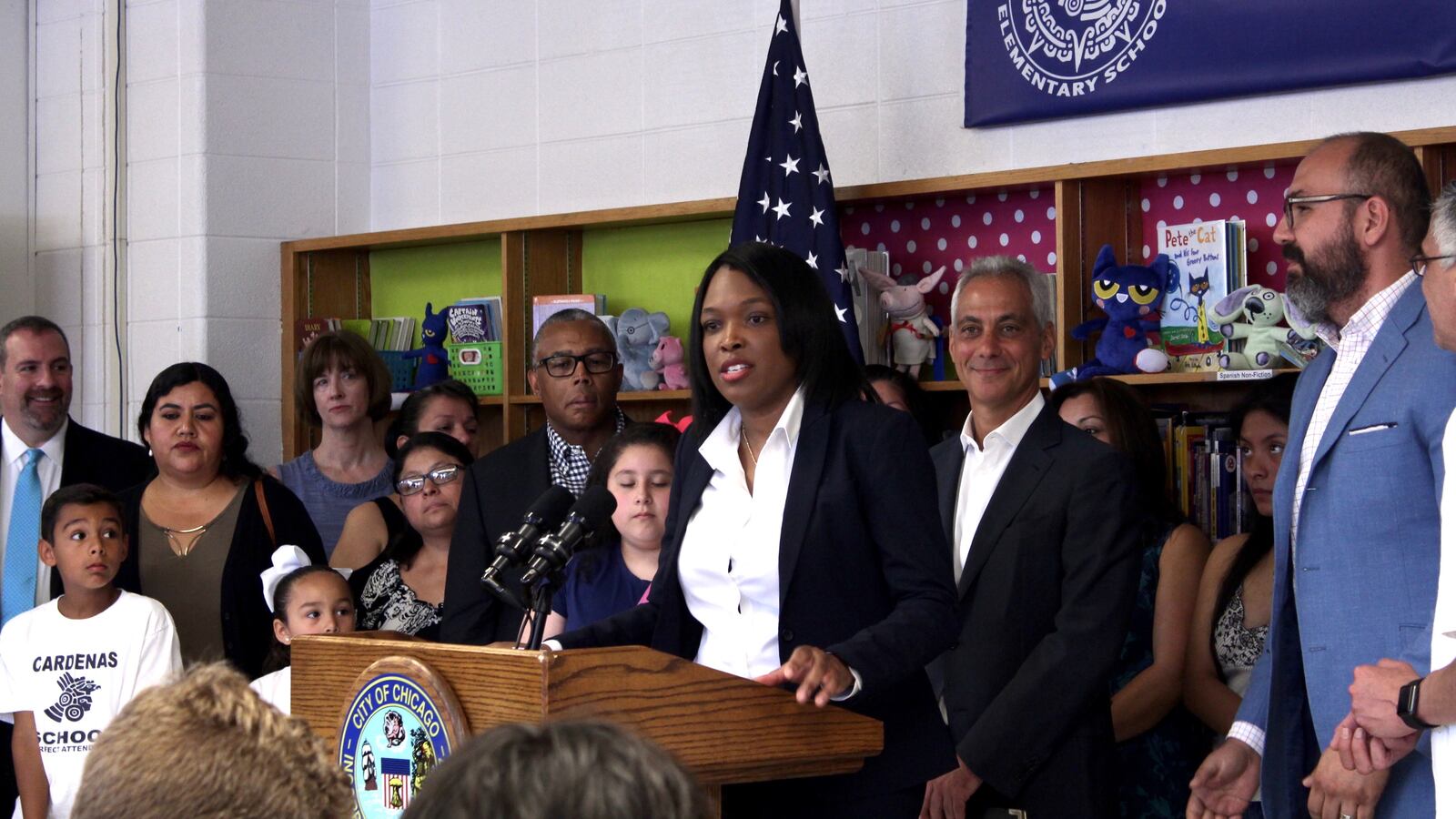Running Chicago’s schools might be the toughest tour of duty in town for a public sector CEO. There have been eight chiefs in a decade – to be fair, two were interims – who have wrangled with mounting debt, aging buildings, and high percentages of students who live in poverty.
Then there’ve been recurring scandals, corruption, and ethics violations. Since she was officially named to the top job in January, CEO Janice Jackson has had to clean up a series of her predecessors’ lapses, from a special education crisis that revealed families were counseled out of services to a sexual abuse investigation that spotlighted a decade of system failures at every level to protect students.
But with budget season underway, the former principal finally gets the chance to go on the offensive. The first operations budget of her tenure is a $5.98 billion plan that contains some good news for a change: 5 percent more money, courtesy of the state revamp of the school funding formula and a bump from local tax revenues. CPS plans to funnel $60 million more to schools than it did last school year, for a total of $3.1 billion. Put another way, it plans to spend $4,397 per student as a base rate — a 2 percent increase from the year prior.
CPS’ total budget comes out to $7.58 billion once you factor in long-term debt and an ambitious $1 billion capital plan that is the focus of a trio of public hearings Thursday night. When it comes to debt, the district owes $8.2 billion as of June 30, or nearly $3,000 per every Chicago resident.
“The district, without a doubt, is on firmer footing than it was 18 months ago, but they’re not out of woods yet,” said Bobby Otter, budget director for the Center for Tax and Budget Accountability. “When you look at the overall picture (the $7.58 budget), they’re still running a deficit. This is now the seventh year in a row they are running a deficit, and the amount of debt the district has, combined with the lack of reserves, leaves them with little flexibility.”
Earlier this week, standing in front of an audience of executives at a City Club of Chicago luncheon, Jackson acknowledged that it had been an “eventful” seven months and said she was ready to focus on strategies for moving the district forward. “I won’t be waiting for next shoe to drop or wasting time and resources waiting for next problem. I want to design a system to educate and protect children.”
“I’m not in crisis mode,” she added.
Here’s what that looks like in her first year when you just consider the numbers. The biggest line items of any operating budget are salaries, benefits and pensions: Taken all together, they consume 66 percent of CPS’ planned spending for the 2018-2019 school year. Rounding out much of the rest are contracts with vendors ($542.6 million, or 9 percent), such as the controversial janitorial deals with Aramark and SodexoMAGIC; charter expenditures ($749 million, or 13 percent); and spending on transportation, textbooks, equipment, and the like (12 percent).
A closer look at how some of those items are allocated offers a window into Jackson’s vision. The Board of Education is scheduled to vote on the plan July 25.
Investing in choice
Earlier this month, the district announced a nearly $1 billion capital plan, funded by bonds, that would support new schools, technology upgrades, and annexes at some of the district’s most popular campuses. The operating budget, meanwhile, accounts for the people and programs driving those projects. It proposes nearly doubling the staff, from 10 to 17, in the office that manages charters, contract programs, and the creation of new schools. It reestablishes a chief portfolio officer who reports directly to the CEO. And it adds expands access to International Baccalaureate programs and Early College STEM offerings. In a letter at the beginning of the 2019 Budget Book, Jackson said such expansions “move the district closer to our goal of having 50 percent of students earn at least one college or career credential before graduating high school.”
Advocating for students
The budget seeds at least two new departments: a four-person Office of Equity charged with diversifying the teacher pipeline, among other roles, and a 20-person Title IX office that would investigate student abuse cases, including claims of student-on-student harassment.
Leaning into high schools
Fitting for a budget designed by a former high school principal – Jackson was running a high school before age 30 – the plan leans in to high schools, establishing $2 million to fund four new networks to oversee them. (That brings the total number of networks to 17; networks are mini-administrative departments that track school progress, assist with budgeting, and ensure policy and procedures are followed.) And it earmarks $75 million across three years for new science labs at neighborhood high schools. What’s more, it supports 10 additional career counselors to help campuses wrestle with a graduation mandate – set forth by Mayor Rahm Emanuel – that seniors have a post-secondary plan to graduate starting with the Class of 2020.
Throwing a lifeline to small schools
The budget also sets forth a $10 million “Small Schools Fund” to help schools with low enrollment retain teachers and offer after-school programs. It also earmarks an additional $5 million to help schools facing precipitous changes in enrollment, which can in turn lead to dramatic budget drops.
Supporting modest staff increases
After a round of layoffs were announced in June, the budget plan adds at least 200 teachers. But the district would not provide a clear accounting of whom to Chalkbeat by publication time. Earlier this week, it announced plans to fund additional school social workers (160) and special education case managers (94).

As Chicago Teachers Union organizer and Cook County Commissioner candidate Brandon Johnson pointed out in an impromptu press conference earlier this week in front of district HQ, the budget is still “woefully short” on school psychologists, nurses, and counselors. And it doesn’t address the calls from parents to restore librarians and instructors in such subjects as art, music, physical education — positions that have experienced dramatic cuts since 2011. “What is proposed today still leaves us short of when (Mayor Emanuel) took office,” Johnson said. “The needs of our students must be met.”
Principal Elias Estrada, who oversees two North Side schools, Alcott Elementary and Alcott High School, said he was still figuring out how the additional staffing would work. He’s getting another social worker – but he oversees two campuses that sit three miles apart, so he figures he’ll have to divide the person’s time between campuses. Estrada asked the board at Monday’s budget hearing to help him understand the criteria it uses to determine which schools get extra staff or additional programs, like IB. “I need a counselor, a clerk, and an assistant principal,” he said; currently those positions also are shared between the elementary and the high school.
After the meeting, he said that schools might have gotten slightly bigger budgets this year, but the increase was consumed by rising salaries and he wasn’t able to add any positions. What’s more, his building needs repairs, but it didn’t get picked for any of the facilities upgrades in the $1 billion capital plan that accompanied the budget.
“What is the process?” he asked. “The need is everywhere.”
At two public hearings on Monday, fewer than a dozen speakers signed up to ask questions of the board, central office administrators, or Jackson.
To see if your school is getting one of the newly announced positions or any funding from the capital plan, type it in the search box below.

